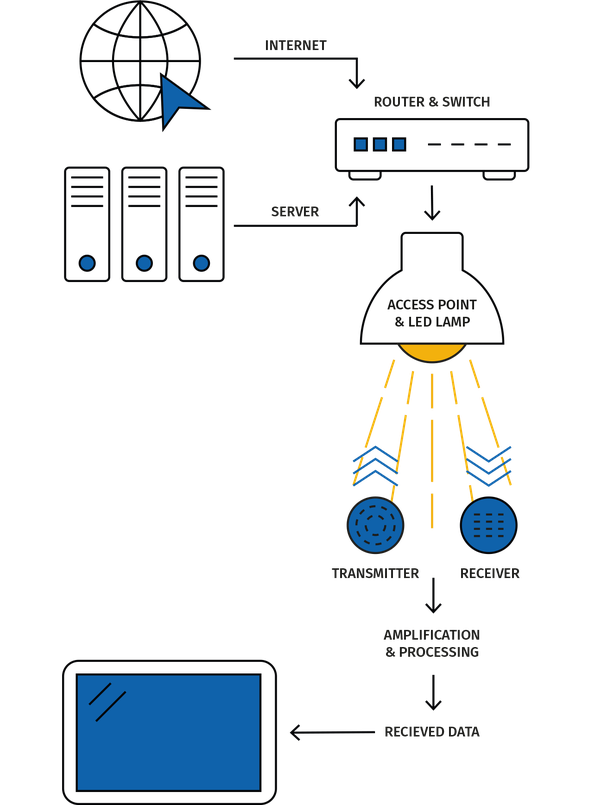LiFi Technology
What Is LiFi?
Other than VLC (visible light communication), which is defined as a point to point connection between two devices, LiFi creates a full scale, light based network similar to radio frequency based communication.
The electromagnetic spectrum suitable for LiFi communication ranges from 200 THz up to 800 THz, so both invisible (infrared) and visible light spectrum can be used for data transmission.

How Does LiFi Work?
LiFi access points provide wireless access to the local network and at the same time could also act as general illumination units. The downstream is generated by the LEDs of the light fixture.
The connecting devices contain a sensor to receive the data stream as well as a transmitting unit (IR diode) to provide the upstream to the access point.
Several users can be connected per access point, and seamless handover between access points creates a connectivity experience which is known from conventional WiFi or cellphone networks.
The number of possible users per access point is rising rapidly, with the evolution of the LiFi technology.
No direct line of sight between sensor and access point is required, the data stream is maintained also by reflection from surfaces like walls and other objects.
LiFi Advantages

Security
Unlike radio waves, light waves are blocked by physical barriers like walls or shaded windows. This makes it possible to contain the signal in an enclosed area, minimizing the risk of network penetration and jamming.

Eco Friendly
LiFi could save energy by combining two functionalities: lighting and connectivity. In principle, the infrastructure needed for the LiFi data link is already there – the LED light installations.

Data Density
Greater bandwidth, more speed – LiFi performance highly outranges WiFi in lab environment. We will bring this performance to the market and to your applications.

No Health Concerns
Radiowaves are present all over the world, penetrating and affecting live tissue. Density and coverage area of electromagnetic fields is rising constantly, to keep up with the demand for wireless communication – increasing electrosmog day by day. LiFi drastically reduces electrosmog. Light waves do not penetrate your body.
F.A.Q.
Frequently Asked Questions
LiFi, short from “light fidelity”, is a wireless communication technology that can use visible light, or infrared spectrum to transmit data at a high-speed. In most cases, infrared is used to be independent of the illumination. In some cases, LiFi is integrated into illumination.
A LiFi system consists of two main devices: an access point and a receiver (dongle).
The aeroLiFi access point transmits data using infrared light (not visible to the human eye) in both uplink and downlink directions. A dongle can be plugged into any device, like a laptop, mobile phone, or tablet, and can instantly establish a data connection with an access point. The dongle is plug-and-play, and no additional effort is needed to use it.
As soon as you install and connect the access points to your home network and also connect the dongle via USB to your end device you are ready to use LiFi.
Unlike radio waves, light waves are blocked by physical barriers like walls or shaded windows. This makes it possible to contain the signal in an enclosed area, minimizing the risk of network penetration and jamming.
We propose personalised solutions according to your requirements. We are ready to deploy technology demonstrators at any time upon your request.
You can contact us via e-mail to book a private product demonstration.
No, the human eye cannot see LiFi signals. LiFi uses light waves at frequencies that are beyond the range of human vision in the infrared spectrum. Even if LiFi uses the visible light spectrum, these signals cannot be percieved by the eye due to the high modulation speeds of the signal.
LiFi technology can work not only in daylight but also in direct sunlight, as the modulated light can still be detected.
LiFi is based on recognizing rapid changes in light intensity, not absolute or slowly changing levels caused by natural defects in daylight or sunlight. LiFi modulates light at a high rates.
Since sunlight is constant light, it can therefore be filtered by the receiver.
LiFi keeps the data flowing even when the lights are dimmed to an ultra-low level. So yes, you can enjoy both connectivity and a cozy ambiance. If infrared is used for LiFi, it can even be used in complete darkness.
LiFi devices have the advantage of not requiring a direct line of sight between the transmitter and receiver, as they can receive signals that bounce off other surfaces. However, the data transfer rate depends on the signal strength, which, in turn, is affected by the quality of the connection to the light source. Any interference or signal degradation can lead to slower data transmission, with weaker signals resulting in slower rates, while stronger signals typically offer faster data transmission.
Masking a dongle, such as placing a sheet of paper over it, can indeed obstruct its ability to pick up signals effectively. This action essentially blocks the light signals from reaching the dongle, causing a loss of connectivity or data transmission in LiFi technology.
Yes, LiFi can be integrated with existing infrastructure. LiFi technology uses standard LED light fixtures, making it compatible with the existing lighting infrastructure in homes, offices, and public spaces. This means it can be deployed with some modifications to the existing infrastructure.
From the point of view of the end user, LiFi technology is similar to WiFi. The main technical difference is that LiFi uses light waves, while WiFi uses radio frequencies to transmit data.
Yes, LiFi and WiFi can coexist in the same environment without interference. In fact, they can complement each other by providing high-speed data transfer through LiFi in areas where it’s most needed and traditional WiFi for broader coverage. The big benefit of having both technologies is that if one stops working, another one takes over all traffic connections, so you don’t have to worry about problems with connectivity.
LiFi is considered safe for human health as it uses visible and infrared light for data transmission and does not emit harmful radiation. It is a low-risk technology in terms of health concerns.
LiFi technology is suitable for various applications, including indoor wireless communication in offices, hospitals and secure environments. It can also be used in underwater communication and in places where RF signals are restricted or where WiFi signals cannot be reached.
Yes, we provide end-to-end solutions for LiFi connectivity including access points and end devices. Get in touch with us for a personalized solution according to your requirements.
